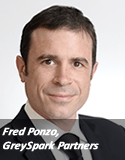FX markets are witnessing an explosion in buy-side to buy-side trading activity as banks increasingly enable their clients to directly access the market, according to research from consultancy GreySpark Partners.
A report by the firm suggests that, as a result of growing use of direct market access (DMA) and sponsored access provision to institutional investors this market is starting to exhibit the characteristics of an all-to-all market.
GreySpark’s analysis of EBS Market, the largest flow FX dealer-to-dealer (D2D) liquidity pool by volume, found that 20% of average daily volume in spot FX liquidity consisted of non-banks meeting other non-banks on the platform. Furthermore, non-banks make up one side of a trade on 35-40% of other spot trades, with the majority being hedge funds and proprietary trading firms.
GreySpark believes this trend for the buy-side to directly access will continue to grow, resulting a full all-to-all market.
“Technology platforms allowing buy-side firms of all ilks – whether they are providing meaningful or non-meaningful liquidity – will become more sophisticated in line with the provision of sell-side service offerings,” the report said.
“It then follows that the existing all-to-all characteristics of D2D flow FX venues will expand over time to cover a wider range of services. Such an increase would create a fully exchange-like trading environment for the vast majority of daily volume transacted in the flow FX market.”
The report also noted similarities in the development of the flow FX business model and the equities market, suggesting sell-side provision of access to the buy-side is become more “utility-like”.
While access offerings among the largest banks in the space have become homogenised as they are in the exchange-traded equities market, the emerging competitive battleground is in the pre-trade space, according to buy-side firms surveyed by GreySpark.
Many brokers now offer transaction cost analysis (TCA) for FX, something which has come to be commonplace in equities, though survey respondents said most of the tools were not of the high standard they expect given experience in equity TCA.
Outside of FX flow, foreign exchange options do not have the same level of all-to-all trading, though GreySpark notes this market has a number of technology platforms looking to develop D2D capabilities, which might result in similar trends in the future. Meanwhile FX non-deliverable forwards are constrained by regulation from developing into a full all-to-all market, though e-trading in these products is expected to increase in future.
The big get bigger
Other research by Greenwich Associates has suggested that among the leading FX banks, the biggest few are amassing more market share than their competitors.
Its research found the five biggest players, Deutsche Bank, UBS, Citi, Barclays and JP Morgan, had amassed combined market share of 53% in 2013. This is a marked increase from 48% in 2012 and 45% in 2011. This trend also seems to be accelerating and in 2005 these banks controlled only 39% of global FX trading volume.
The next five biggest banks by market share saw their total fall to 22% last year, down from a high of 27% in 2011.
Commenting on the reason for this divergence in market share, Greenwich’s head of research for market structure and technology, Kevin McPartland, said: “Several factors are contributing to the growing market share of the top dealers, including higher costs of capital, increasing incentives to clear, the breakdown of the traditional fixing process, and the expanding use of technology.”
